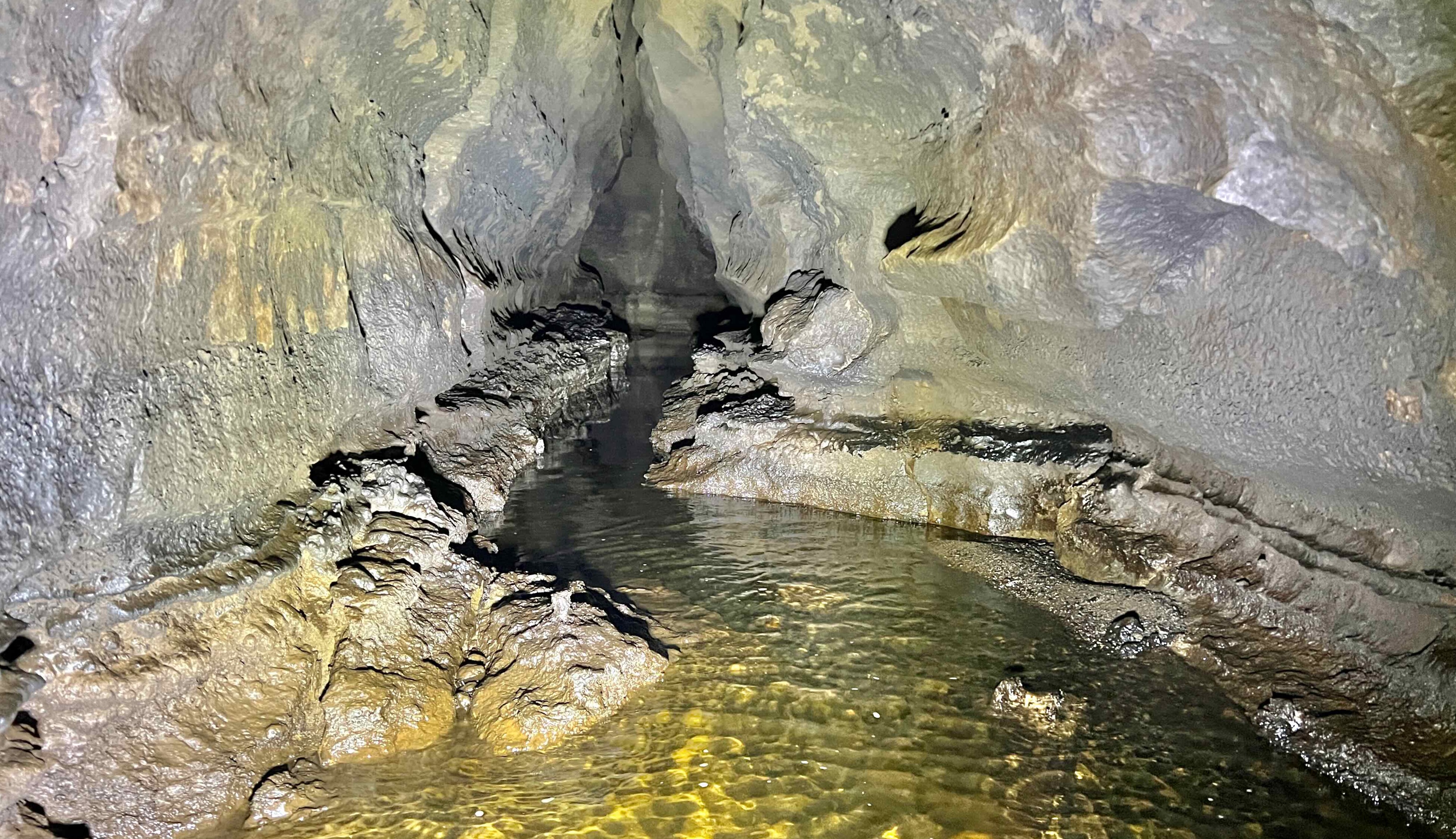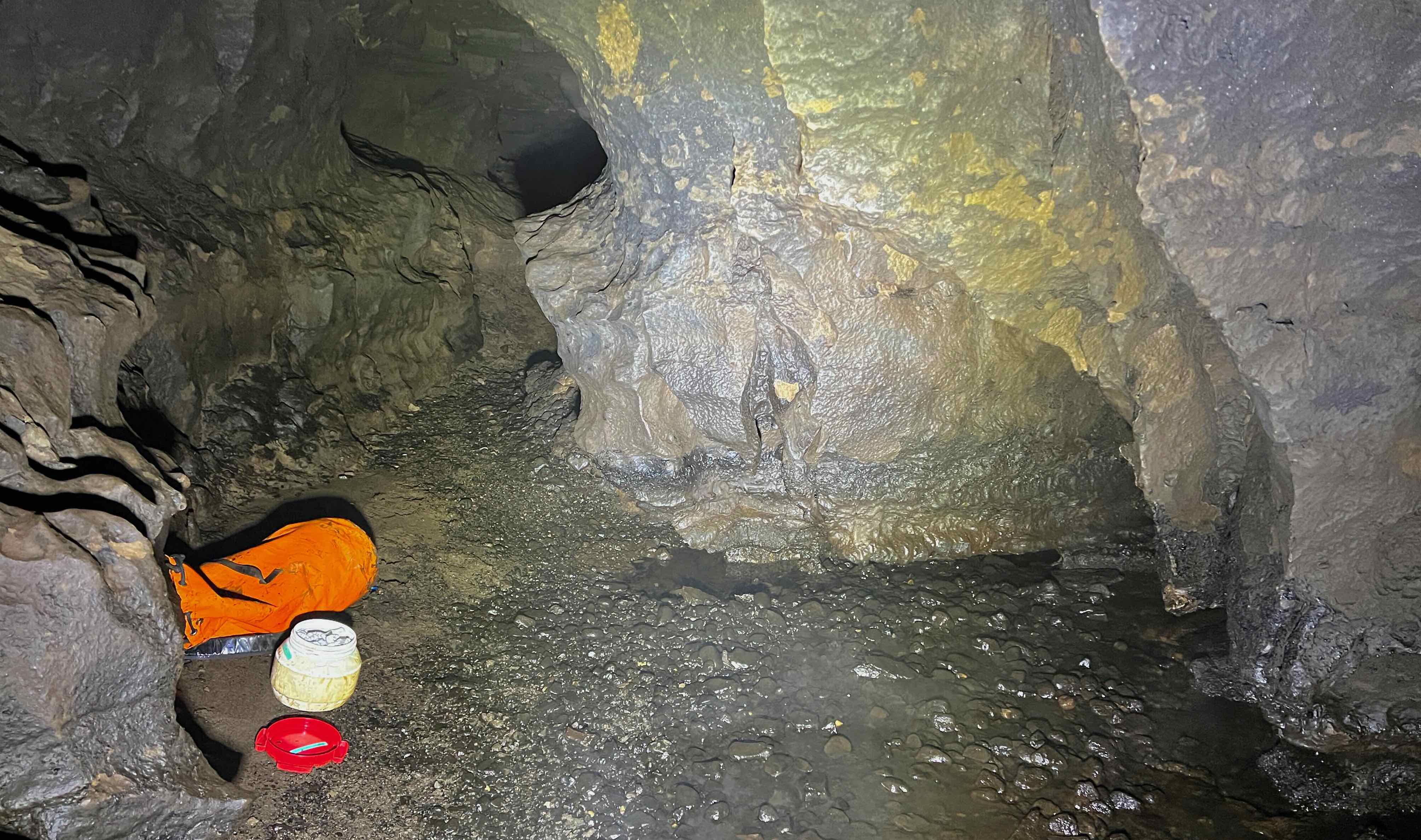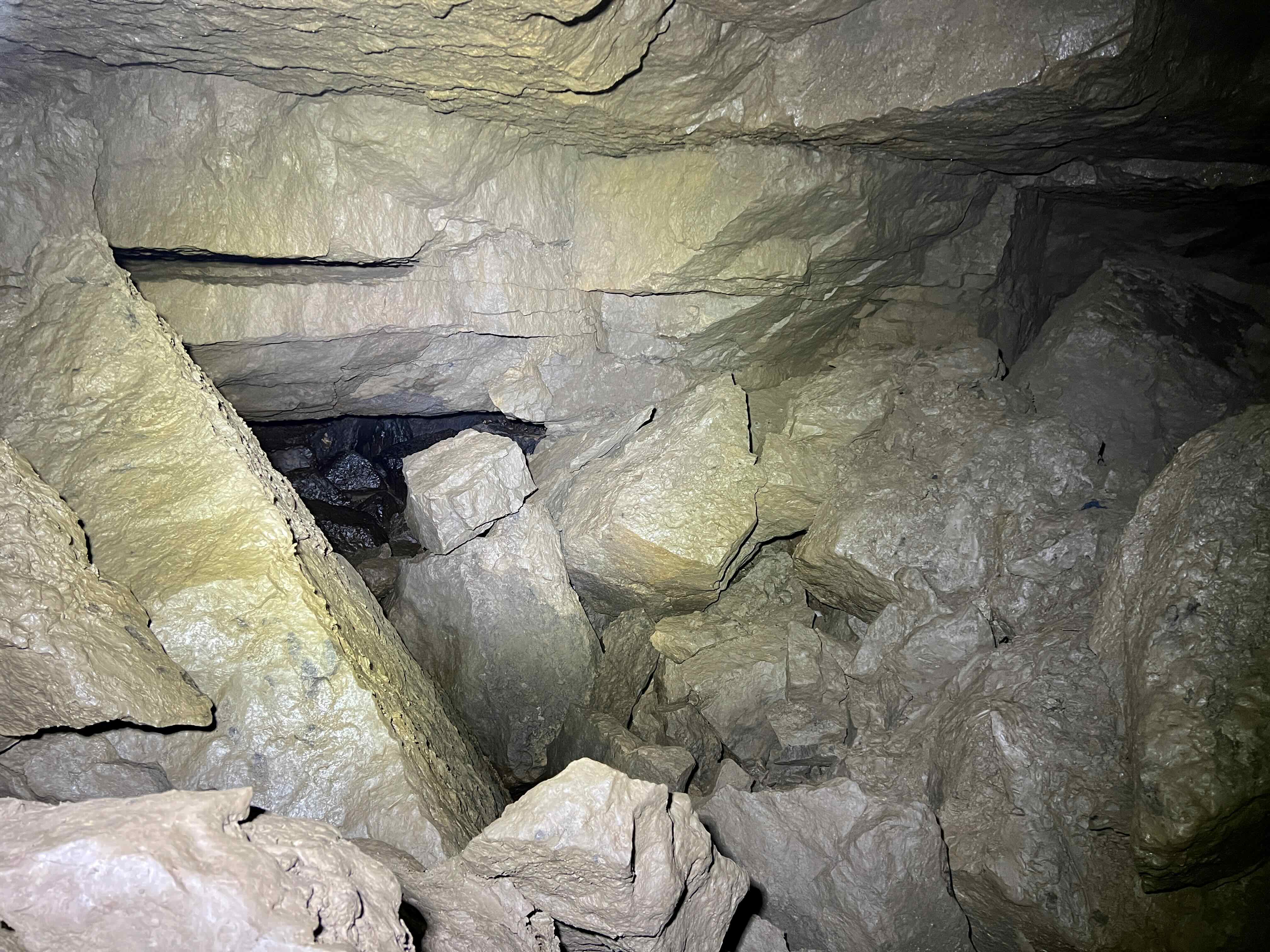A collection of images taken on this trip can be found on caves.app.
It’s quite curious how the human brain perceives time without an outside reference. How long had I been crawling for? It was impossible to know. Could you call it crawling? Not hands and knees, but rather supporting myself with a single arm outstretched in the water and pushing myself sideways along the narrow passage. My helmet scrapes noisily on the rock ceiling and my waist is constricted by each opposite wall. Any sense of progress is impossible – the next bit of passage is completely indistinguishable from the last and all other parts. Had it been twenty minutes? Forty? An hour?
Internally, I mull over whether there is a name for this eccentric method of sideways movement – generally, when people name a technique, it is because it is efficient, effective, or desirable – I’m not sure this is any of those. Everything is relative though, and it did seem to be the better option compared to crawling in the muddy brown water .
My bag is stuck. I attempt to free it blindly with my foot. This inevitably fails, and I must turn around, go backward and release it from whatever unhelpful protrusion has captured one of its straps. I crawl – no, sideways hop, for another few metres. My bag is stuck again. As I unhook it, I start to question what I am doing here at 1 am. Maybe this was a bad idea?
Following the jagged rock tunnel through a relentless series of 90-degree bends, I am often forced to my knees by a lowered roof or occasionally made to crawl on all fours. Constantly changing position seems to be taking just as much time as making forward progress. My internal debate as to how long I have been here is beginning to lose relevance, and I resolve that I should simply keep going until such time the going comes to an end.
A particularly nasty bit of cave soon demands me to be completely flat out in the stream, struggling to push my bag in front of me. Progress is very slow – why did I want to carry lights and cameras for photography? I’d learn for next time – or not. Eventually, a T-junction is salvation from my internal monologue. The torturous entrance series of Oddmire Pot – Strid Passage – has been passed, and the downstream continuation into Hammerdale Dub allows me to stand up properly for the first time since I left Slaughter Aven.

Langcliffe Pot has fascinated me ever since I first heard about it. “What about Langcliffe?”, a more experienced caver had said to me as I sat in the YSS musing about enjoying trips with a sense of journey. “That one has got miles of passages. It’ll take you hours to get to the end”. Later, reading Simon Beck’s trip reports and other discussions on UK Caving only piqued my interest more.
On Monday evening, I’d finished work and still felt full of energy when Langcliffe entered my thoughts once again. I promptly decided to cook myself a hearty meal and then drive over to Kettlewell, where I arrived just after 11 pm. Laminated copy of Not For The Faint Hearted in hand, I intended to go as far as possible in the system, despite being quite nervous about the two notorious boulder chokes protecting the far reaches.
I walked through the thick darkness, with clouds obscuring the moonlight, and found myself atop the fell using my GPS to make my way slowly and deliberately towards the cave. Suddenly, a shotgun blast went off – it sounded quite close. I froze and turned my light off. Not what you want at midnight in the countryside, is it? I stood still for some time, and when nothing was seen or heard, carried on using only a small red light. Ten minutes later, a second shotgun blast was heard – thankfully, this seemed further away and gave me the confidence to turn my light back on to speed progress.
Reaching the entrance, I discovered that the boulder pile just inside Oddmire Pot – Slaughter Aven – is uniformly coated with a disgusting brown excretion that seems to be most attracted to ropes, gloves, and oversuits. As someone who quite likes to keep clean, I often think that perhaps caving isn’t the right hobby for me. Navigating my way down the exceptionally loose boulders, I soon found myself at the start of Strid Passage (as described above). Despite the unpleasant nature of it, I felt quite safe and secure relative to being exposed on a dark fell with gunshots around.

Back to where we left off, Hammerdale Dub marks the start of around 45 minutes of easy and enjoyable caving – a welcome change. Most of this time is spent in the spacious streamway of Langstrothdale Chase, which is separated from Hammerdale Dub by the Kilnsey Boulder Crawl , an enjoyable dry bypass. Contrary to the name, it did not involve too much crawling and was a pleasant 10 minutes away from the water.
Langstrothdale Chase has it all. It is an impressively tall vadose passage , which is generously wide, and not too much trouble underfoot. One section involves waist-deep wading in a canal, whilst others involve dry and sandy bypasses next to – or sometimes entirely separate from – the stream. Strolling along here, making very quick progress, was the highlight of the trip. The stark contrast of this fantastic bit of cave to the dismal entrance series gave way to a sense of euphoria and accomplishment – it had all been worth it. It feels quite remote down here, and you innately understand the privilege it is to be in such a rarely visited, yet beautiful, place.
The streamway eventually degenerates into a mess of boulders, and a dry continuation gets progressively smaller until two flat-out squeezes are met. These are tight in all dimensions, and sufficiently irritating when solo with a bag. I stare at each squeeze hesitantly before making my way through. I don’t think they’d be a problem in any other cave, however, being alone in such a remote place causes you to think twice before introducing another obstacle to an already lengthy exit route. Nonetheless, the squeezes were passed without too much trouble, only requiring me to remove my SRT kit first.
The water in Boireau Falls Chamber can now be heard, and despite the description stating that the way on is a crawl immediately on the left after the second squeeze, I am drawn to an appealing passage straight ahead – which soon hits a dead end. Retracing my steps, I soon pop out into the spacious, flat-roofed chamber above the large boulder choke. The water emerges from under the left wall and cascades over and between boulders, leaving a section clean washed , whilst those rocks above the flow are coated in a thick layer of mud and topped with the ancient carbide deposits of past explorers.

It is interesting to think of what has happened in this chamber. Almost every visitor to the cave will have stopped here to rest, and it was the gathering point for rescue teams searching for the Brook brothers and their companions when they got trapped by flooding in the late 60s. Being alone, I felt strangely comforted by the many footsteps. How old are they, I wonder? Before the advent of LED lights, technical clothing, and up-to-the-minute weather radar, those original explorers faced much more challenging conditions than I do today. Regardless, they sat here and pondered their next move, just as I was doing now.
Apprehensively studying the infamous squeeze in the floor of the chamber made me question just how far I wanted to progress today. The way on – a 1.5 metre vertical drop between tightly packed boulders – looked incredibly intimidating and I wasn’t sure if I fancied my chances of getting back out without someone to pull me. Sat on the edge of the hole, I poked my legs through and felt around for any footholds which might assist my ascent. I couldn’t feel any – surely there must be a way! Lowering myself carefully into the void, I searched for a ledge or boulder to support my weight. Suddenly, my arms slipped on the muddy boulders, and my body fell downwards. My hips became wedged in the hole, my legs were hanging freely below me, and my chest was emerging from the top.
I’d inadvertently inserted myself, assisted by gravity, at entirely the wrong angle to pass the obstacle. Committing to the squeeze and finding a way back up from beneath was an option, but it was psychologically easier to try and get out from this position. Slow and arduous progress upwards was made, lifting myself methodically with my upper body and then resting on my elbows to prevent me from slipping back down. My legs were an entirely useless burden without footholds beneath and it took quite some time and effort to release myself. Eventually, relief came, and it was clearly time to turn around and head out. I knew now that I could escape the squeeze, but I didn’t fancy doing it again today. The unwelcome slog outwards began.
Caves often seem to pass more quickly on the return journey. This certainly wasn’t the case with Strid Passage. It seemed endless on the way in, and yet it had somehow doubled in size on the way out. The relief of reaching the bottom of Slaughter Aven was immense and now only a few minutes of ropework separated me from the surface. Soon after, the daylight was a welcome sight, having last seen it when I was in the car the evening before.
Langcliffe Pot is an incredibly intriguing place and my unpleasant encounter with the squeeze in Boireau Falls Chamber has only renewed my enthusiasm to see what is on the other side. As soon as the weather is suitable, I’ll be back for round two.
This report was posted on UKCaving, if you'd like to comment.
